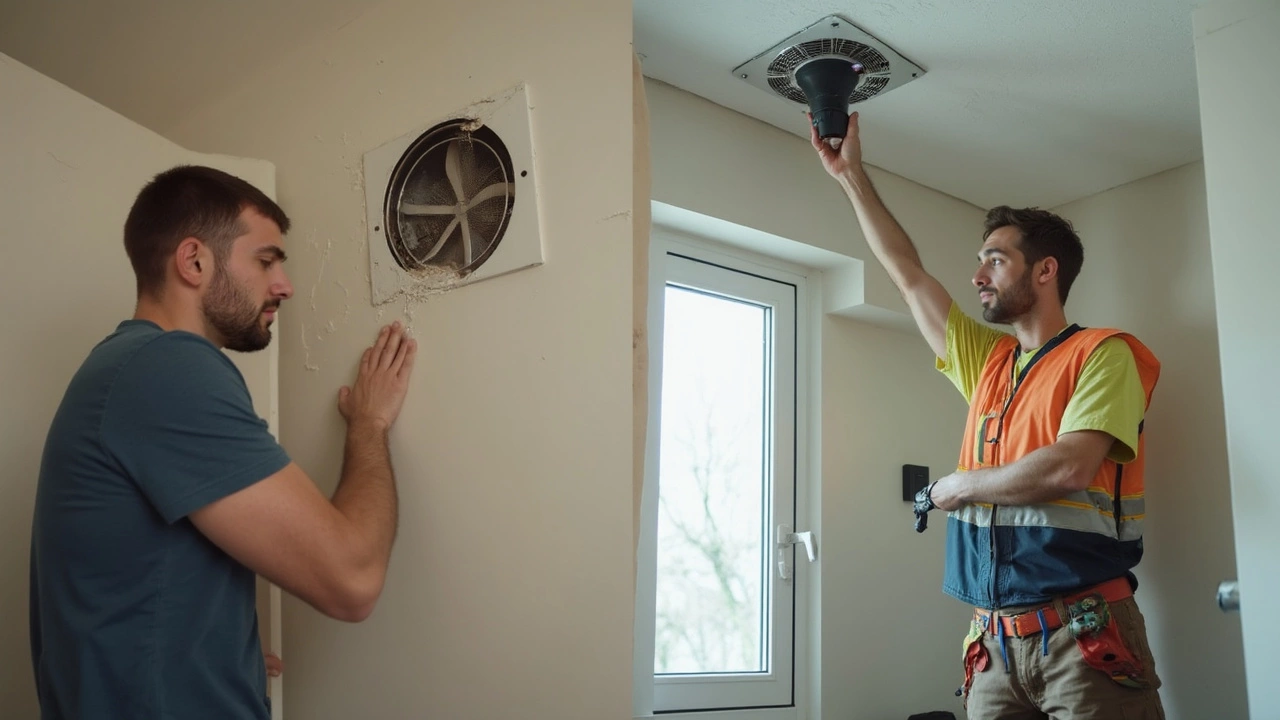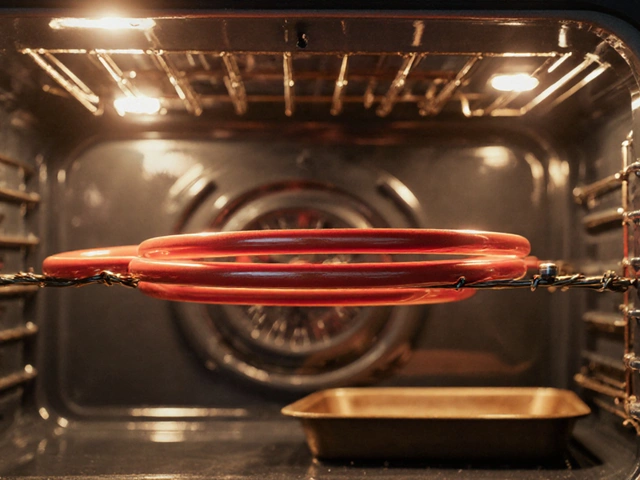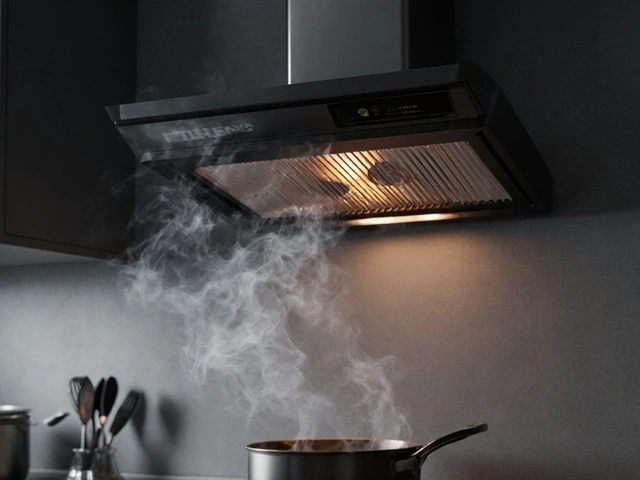Extractor fans don’t just quit for no reason. Usually, they get noisy, stop spinning, or just stop pulling air. Some people think once a fan acts up, you need a brand new one. That’s not true—sometimes the fix is simpler than you think.
The honest truth is, lots of common issues—like rattling, slow spinning, or weird smells—are signs you can tackle yourself, especially if you’ve got a screwdriver and a half-hour to spare. Dirty blades and clogged filters? A quick clean can solve that. A loose cover or a bit of grime in the motor can turn an annoying fan into a working one.
Before you reach for your wallet, take a close look at what’s really wrong. Most problems show up slowly, not all at once. Notice a sudden grinding? Maybe a build-up is causing the trouble, not a broken motor. If the fan just won’t start, it could be a simple wire connection or a blown fuse in the system.
- Why Do Extractor Fans Break Down?
- What Problems Can You Fix Yourself?
- Parts You Might Need to Replace
- When Does It Make Sense to Call an Expert?
- Repairing Versus Replacing: What’s Worth It?
Why Do Extractor Fans Break Down?
Extractor fans do a dirty job, pulling out moisture, heat, grease, and smells day in and day out. That means they collect mess fast. Most breakdowns trace back to build-up inside the fan or just regular wear and tear. The main things that go wrong aren't mysteries—they pop up in homes and kitchens everywhere.
Here are the biggest reasons for failure:
- Extractor fan blades get gummed up with dust, grease, and lint. This makes them heavy and hard to turn.
- Motors overheat if dust blocks up the airflow, starving the fan of air and cooling.
- Electrical connections work loose from vibration or old age, cutting power or making the fan cut in and out.
- Bearings dry out or break down, leading to annoying squeals or a totally jammed fan.
- Cheap plastic parts simply snap when the fan gets older.
Here’s a quick look at what usually breaks in an extractor fan and how often people notice these issues:
| Common Fault | How Often It Shows Up |
|---|---|
| Dusty or greasy blades | Every 3-6 months |
| Noisy or seized bearings | After 2-3 years |
| Loose wiring | Every 1-2 years |
| Broken blades or grille | After 3+ years |
| Burnt-out motor | After 5+ years (if not cleaned) |
Most extractor fans aren't built like tanks. The typical bathroom or kitchen model is made to last around 5-10 years, depending on how much you use it and how clean you keep it. A well-maintained fan usually lasts longer, while one left to clog up with dust or steam may sputter out long before it should.
What Problems Can You Fix Yourself?
A lot of extractor fan issues look serious at first, but with a little time and some basic tools, you can sort out more than you might expect. Most fans aren’t that complicated. If you know what signs to watch for, you could avoid a pricey callout or a full-on replacement.
- Extractor fan running loud? Odds are it’s just dusty or the cover is loose.
- Fan smells odd? It could be a build-up of grease or mold—usually a sign it badly needs a clean.
- Fan isn’t spinning as strong? Check the blades and filter area for any blockages or gunk stopping the motor.
- No power at all? Sometimes it’s just a tripped circuit breaker or loose wiring at the switch.
Here’s a quick guide for easy fixes:
- Turn off power first—Flip the switch and shut off the breaker just to be safe.
- Remove the outer cover and check for dust, grease, or debris around the blades and inside the housing.
- Wipe fan blades, covers, and nearby surfaces using a damp cloth and some mild soap.
- Check for any loose screws on the cover or the motor mount and tighten them up.
- If the fan hums but doesn’t spin, use a stick (never your fingers) to gently move the blades. If they spin freely, it might just be stuck from grime.
- Inspect wiring connections if you’re handy with electricity (and confident about what you’re doing). Look for obvious signs of wear or disconnection.
About 60% of extractor fans that stop working only need cleaning or tightening, based on recent surveys by real-world appliance repair shops. The table below shows the most common fan issues and what percentage are fixed without replacing any parts:
| Problem | Fixable Without Parts (%) |
|---|---|
| Noisy operation | 75% |
| Weak airflow | 65% |
| Bad odor | 80% |
| Won't start | 40% |
If your fan has obvious burning smells, melted parts, or shocks you when you touch it, skip the DIY and bring in a professional. But in most homes, extractor fan hiccups are just dirt and loose bits—cheap and easy to handle yourself.

Parts You Might Need to Replace
When it comes to getting your extractor fan back on track, sometimes a quick clean won’t cut it—you’ll actually need to swap out a piece or two. The good news? Most extractor fans are built from a handful of parts, and a lot of them are easy to find online or at a local hardware shop.
Here’s a look at the parts that most commonly wear out or break:
- Fan Blades: These pick up dust and grease fast. Warped or cracked blades cause noise and cut airflow. If they’re shot, new ones aren’t hard to screw in.
- Motor: The heart of any fan. Motors can burn out, especially in older fans or ones that run nonstop. You can buy a replacement motor, but check the specs—you’ll need one that matches your model exactly.
- Capacitor: This tiny part gets the motor spinning. If your fan hums but doesn’t turn, a busted capacitor could be the reason.
- Grilles and Covers: These might seem minor, but broken or missing covers can mess with how the fan works and create safety issues. Snap or screw on a new cover if you spot any cracks.
- Switches or Pull Cords: If your fan just doesn’t respond, the switch or cord could be the culprit. These are often simple to swap out.
- Filters: For fans in the kitchen, clogged grease filters are a top reason for weak airflow or bad smells. Fresh filters are cheap and can make a big difference.
Wondering how often these get swapped out? It depends on how hard your fan works. Check out this table for a rough idea:
| Part | Average Lifespan |
|---|---|
| Fan Blades | 5-7 years |
| Motor | 8-12 years |
| Capacitor | 5-10 years |
| Grilles/Covers | As needed (when cracked) |
| Switches/Pull Cords | 6-10 years |
| Filters | Every 6-12 months |
Always cut power before opening up your fan to swap a part. Most replacements need just a screwdriver, but don’t force anything—if a part doesn’t fit perfectly, it’s the wrong size. And if you’re totally lost with wiring or motors, don’t push your luck. Sometimes calling an electrician is the smart move.
When Does It Make Sense to Call an Expert?
Tinkering with your extractor fan can be satisfying, but there’s a point where DIY hits a wall. If you’re dealing with electrical stuff, major motor problems, or you’ve tried all the basics and the fan still won’t work, that’s your cue to ring up a pro. Messing with wiring or internal parts without the know-how isn’t just risky—it could end up costing you even more if you make it worse.
Here are clear signs you need an expert:
- Extractor fan trips the circuit breaker or causes fuse issues, especially more than once.
- Burning smells or visible smoke appear when you switch it on.
- You hear loud grinding, clanging, or high-pitched whining from inside the motor.
- Electrical connections look corroded, loose, or burnt.
- You spot water leaks or heavy condensation near the wiring or fan housing.
- The fan is built into a complex duct or hard-to-reach place (like high ceilings or integrated cooker hoods).
When you call an expert, you’re getting someone with the right gear, experience, and safety training. Most tradespeople charge a callout fee, usually around £50-£80 in the UK, and the repair itself depends on what’s busted. Here’s a quick comparison of average repair jobs:
| Issue | DIY Possible? | Average Pro Cost (£) |
|---|---|---|
| Simple clean/unclog | Yes | 0-40 |
| Switch/fuse replacement | Sometimes | 50-90 |
| Motor replacement | No | 100-200 |
| Rewiring damaged lines | No | 120-250 |
One more thing: if your fan’s still under warranty or installed by a builder, calling the manufacturer or installer first can save you time and money. And if the repairs look like they’ll run over half the cost of a new fan, it’s usually smarter to replace than keep sinking cash into fixes.

Repairing Versus Replacing: What’s Worth It?
Trying to figure out if you should bother fixing your extractor fan or just get a new one? You’re not alone—it’s one of the most common questions people have when the fan starts acting up. Here’s what matters most: age, cost, and how bad the fault is.
First off, how old is the unit? If your fan is over 10 years old and you've already fixed it once or twice, replacement usually wins. Motors get weaker, parts wear out, and the latest fans are way more energy efficient. But if it's only a couple years old, or you can spot the exact problem (like a busted switch or loose wire), go for the repair—you'll probably save money.
| Situation | Repair? | Replace? |
|---|---|---|
| Noisy but spins well | ✅ Clean or tighten parts | ❌ Not needed |
| Blown motor | ❌ Often not worth it | ✅ Cheaper to replace |
| Broken propeller | ✅ Replace propeller | ❌ Fan can be saved |
| Age over 10 years | ❌ Parts may not be available | ✅ Upgrade is best |
| Electrical issues/faulty cable | ✅ Replace cable | ❌ Easy fix |
Here’s a quick checklist to help you decide:
- If fixing the fan costs more than half of what a new one does, it’s probably smarter to replace it.
- Replacement parts for older fans can be hard to find. If you’re hunting for hours with no luck, it’s a sign to upgrade.
- If you notice increased energy bills, today’s fans use about 30% less power, so switching could save you cash.
- Mold or weird smells sticking around even after cleaning? Sometimes, old fans just can’t keep up by design—a new one can actually solve real health problems.
If your fan is cracked, making awful noises even after a tune-up, or is on the ancient side, don’t invest in a fix. But for simple fixes like new covers, blades, or switch repairs, you’re usually good just repairing it. Take a look at your time and patience too—sometimes getting a reliable new fan right away just saves headaches.







